| Barrier | |
|---|---|
| Stanley's Barrier Range | |
Location of the Barrier Range in New South Wales near the South Australian border | |
| Highest point | |
| Peak | Mount Robe, 31°39′24″S 141°19′36″E / 31.656680°S 141.326776°E |
| Elevation | 472[1] m (1,549 ft)[2] AHD |
| Coordinates | 31°42′S 141°15′E / 31.700°S 141.250°E[3] |
| Geography | |
| Country | Australia |
| State | New South Wales |
| Range coordinates | 31°30′S 141°30′E / 31.500°S 141.500°E[4] |
The Barrier Ranges or sometimes the Barrier Range and historically the Stanley's Barrier Range, is a mountain range that comprises a series of hills and higher grounds in the far western region of New South Wales, Australia, surrounding the city of Broken Hill.
YouTube Encyclopedic
-
1/1Views:508
-
Gobi Desert
Transcription
Location and features
The Barrier Ranges comprise the whole system of ranges and ridges associated with the main watershed named the Main Barrier Range - including Coko Range, Floods Range, Slate Range, Robe Range, Mundi Mundi Range, Coonbaralba Range and Mount Darling Range. The city of Broken Hill lies within these ranges.[4]
The ranges is oriented in a roughly north-south direction, east of the border between New South Wales and South Australia. It is an area of slightly higher ground lying between the lower lands along the Darling River, and lower ground in South Australia. The Barrier Ranges contains a number of mineral deposits, most notably Broken Hill.
It was reported in October 1856 that, 'within the last year or two numerous sheep-stations have been opened in the Barrier Ranges, affording a reasonable prospect, not only of increased pastoral wealth, but also of the gradual development of the mineral resources of the district and its ultimate settlement.'[5]
Etymology
The name of the Barrier Highway and various local organisations in Broken Hill including the word 'barrier', are derived from the name of this range. In 1844, during his third and final expedition, Charles Sturt named the range Stanley's Barrier Range in honour of Lord Stanley.[6]
See also
References
- ^ Quigley, Mark Cameron (September 2006). Continental tectonics and landscape evolution in south-central Australia and southern Tibet (PDF). Retrieved 16 June 2019.
- ^ "Map of Barrier Ranges, NSW". Bonzle Digital of Australia. Retrieved 6 May 2015.
- ^ "Lewis Peak". Geographical Names Register (GNR) of NSW. Geographical Names Board of New South Wales. Retrieved 6 May 2015.
- ^ a b "Barrier Ranges". Geographical Names Register (GNR) of NSW. Geographical Names Board of New South Wales. Retrieved 6 May 2015.
- ^ South Australian Register newspaper, 15 October 1856, page 2.
- ^ Cumpston, John Howard Lidgett (1951). Charles Sturt - His Life and Journeys of Exploration. Melbourne: Georgian House. Retrieved 4 December 2012.

